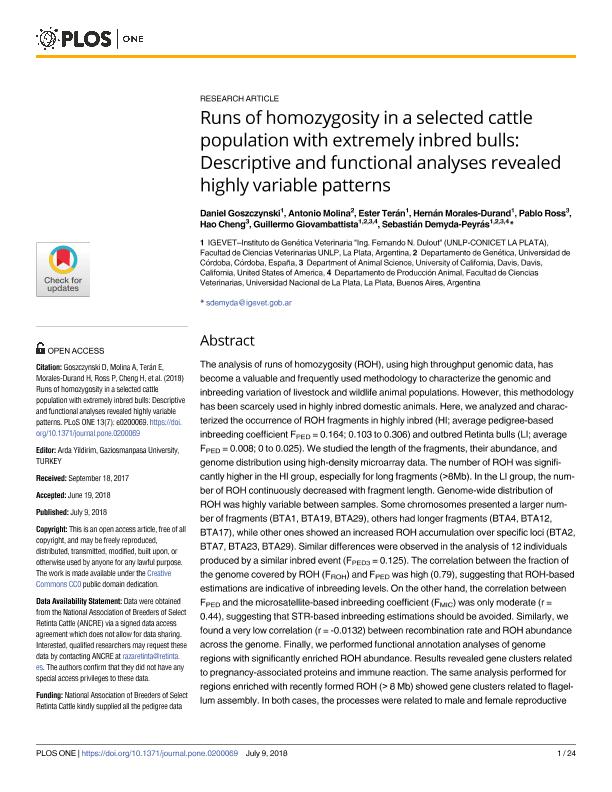Mostrar el registro sencillo del ítem
dc.contributor.author
Goszczynski, Daniel Estanislao

dc.contributor.author
Molina, Antonio
dc.contributor.author
Teran, Ester Mercedes

dc.contributor.author
Morales-Durand, Hernán
dc.contributor.author
Ross, Pablo
dc.contributor.author
Cheng, Hao
dc.contributor.author
Giovambattista, Guillermo

dc.contributor.author
Demyda-Peyrás, Sebastian

dc.date.available
2019-09-02T19:45:30Z
dc.date.issued
2018-07
dc.identifier.citation
Goszczynski, Daniel Estanislao; Molina, Antonio; Teran, Ester Mercedes; Morales-Durand, Hernán; Ross, Pablo; et al.; Runs of homozygosity in a selected cattle population with extremely inbred bulls: Descriptive and functional analyses revealed highly variable patterns; Public Library of Science; Plos One; 13; 7; 7-2018; 1-24
dc.identifier.issn
1932-6203
dc.identifier.uri
http://hdl.handle.net/11336/82758
dc.description.abstract
The analysis of runs of homozygosity (ROH), using high throughput genomic data, has become a valuable and frequently used methodology to characterize the genomic and inbreeding variation of livestock and wildlife animal populations. However, this methodology has been scarcely used in highly inbred domestic animals. Here, we analyzed and characterized the occurrence of ROH fragments in highly inbred (HI; average pedigree-based inbreeding coefficient FPED = 0.164; 0.103 to 0.306) and outbred Retinta bulls (LI; average FPED = 0.008; 0 to 0.025). We studied the length of the fragments, their abundance, and genome distribution using high-density microarray data. The number of ROH was significantly higher in the HI group, especially for long fragments (>8Mb). In the LI group, the number of ROH continuously decreased with fragment length. Genome-wide distribution of ROH was highly variable between samples. Some chromosomes presented a larger number of fragments (BTA1, BTA19, BTA29), others had longer fragments (BTA4, BTA12, BTA17), while other ones showed an increased ROH accumulation over specific loci (BTA2, BTA7, BTA23, BTA29). Similar differences were observed in the analysis of 12 individuals produced by a similar inbred event (FPED3 = 0.125). The correlation between the fraction of the genome covered by ROH (FROH) and FPED was high (0.79), suggesting that ROH-based estimations are indicative of inbreeding levels. On the other hand, the correlation between FPED and the microsatellite-based inbreeding coefficient (FMIC) was only moderate (r = 0.44), suggesting that STR-based inbreeding estimations should be avoided. Similarly, we found a very low correlation (r = -0.0132) between recombination rate and ROH abundance across the genome. Finally, we performed functional annotation analyses of genome regions with significantly enriched ROH abundance. Results revealed gene clusters related to pregnancy-associated proteins and immune reaction. The same analysis performed for regions enriched with recently formed ROH (> 8 Mb) showed gene clusters related to flagellum assembly. In both cases, the processes were related to male and female reproductive functions, which may partially explain the reduced fertility associated with inbred populations.
dc.format
application/pdf
dc.language.iso
eng
dc.publisher
Public Library of Science

dc.rights
info:eu-repo/semantics/openAccess
dc.rights.uri
https://creativecommons.org/licenses/by/2.5/ar/
dc.subject
Roh
dc.subject
Cattle
dc.subject
Inbreeding
dc.subject.classification
Otras Ciencias Veterinarias

dc.subject.classification
Ciencias Veterinarias

dc.subject.classification
CIENCIAS AGRÍCOLAS

dc.title
Runs of homozygosity in a selected cattle population with extremely inbred bulls: Descriptive and functional analyses revealed highly variable patterns
dc.type
info:eu-repo/semantics/article
dc.type
info:ar-repo/semantics/artículo
dc.type
info:eu-repo/semantics/publishedVersion
dc.date.updated
2019-08-08T19:33:58Z
dc.journal.volume
13
dc.journal.number
7
dc.journal.pagination
1-24
dc.journal.pais
Estados Unidos

dc.journal.ciudad
San Francisco
dc.description.fil
Fil: Goszczynski, Daniel Estanislao. Consejo Nacional de Investigaciones Científicas y Técnicas. Centro Científico Tecnológico CONICET- La Plata. Instituto de Genética Veterinaria "Ing. Fernando Noel Dulout". Universidad Nacional de La Plata. Facultad de Ciencias Veterinarias. Instituto de Genética Veterinaria; Argentina
dc.description.fil
Fil: Molina, Antonio. Universidad de Córdoba; España
dc.description.fil
Fil: Teran, Ester Mercedes. Consejo Nacional de Investigaciones Científicas y Técnicas. Centro Científico Tecnológico CONICET- La Plata. Instituto de Genética Veterinaria "Ing. Fernando Noel Dulout". Universidad Nacional de La Plata. Facultad de Ciencias Veterinarias. Instituto de Genética Veterinaria; Argentina
dc.description.fil
Fil: Morales-Durand, Hernán. Consejo Nacional de Investigaciones Científicas y Técnicas. Centro Científico Tecnológico CONICET- La Plata. Instituto de Genética Veterinaria "Ing. Fernando Noel Dulout". Universidad Nacional de La Plata. Facultad de Ciencias Veterinarias. Instituto de Genética Veterinaria; Argentina
dc.description.fil
Fil: Ross, Pablo. University of California at Davis; Estados Unidos
dc.description.fil
Fil: Cheng, Hao. University of California at Davis; Estados Unidos
dc.description.fil
Fil: Giovambattista, Guillermo. Consejo Nacional de Investigaciones Científicas y Técnicas. Centro Científico Tecnológico CONICET- La Plata. Instituto de Genética Veterinaria "Ing. Fernando Noel Dulout". Universidad Nacional de La Plata. Facultad de Ciencias Veterinarias. Instituto de Genética Veterinaria; Argentina. Universidad de Córdoba; España. University of California at Davis; Estados Unidos
dc.description.fil
Fil: Demyda-Peyrás, Sebastian. Consejo Nacional de Investigaciones Científicas y Técnicas. Centro Científico Tecnológico CONICET- La Plata. Instituto de Genética Veterinaria "Ing. Fernando Noel Dulout". Universidad Nacional de La Plata. Facultad de Ciencias Veterinarias. Instituto de Genética Veterinaria; Argentina. Universidad de Córdoba; España. University of California at Davis; Estados Unidos
dc.journal.title
Plos One

dc.relation.alternativeid
info:eu-repo/semantics/altIdentifier/url/https://journals.plos.org/plosone/article?id=10.1371/journal.pone.0200069
dc.relation.alternativeid
info:eu-repo/semantics/altIdentifier/doi/http://dx.doi.org/10.1371/journal.pone.0200069
Archivos asociados
